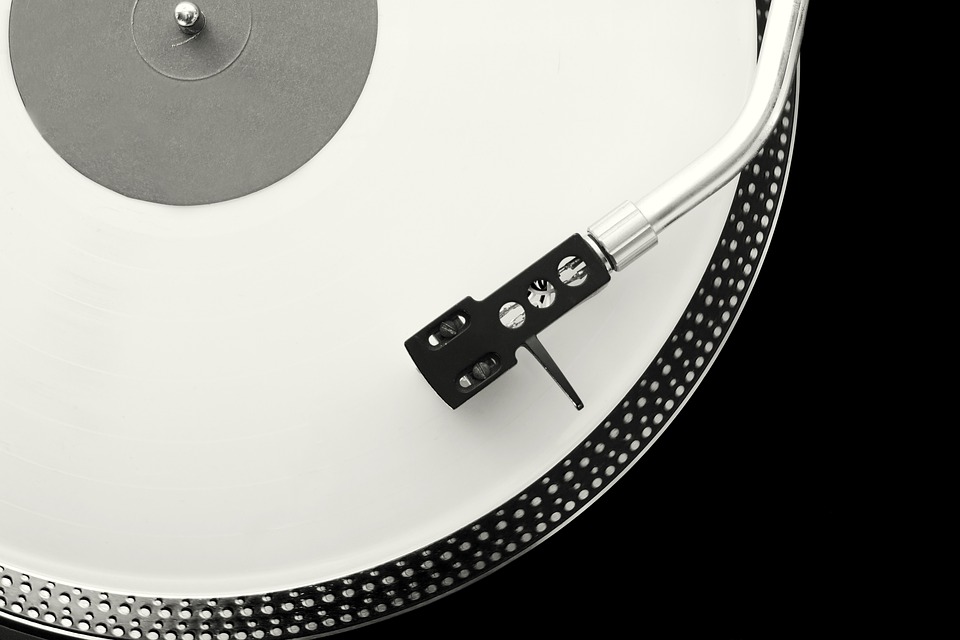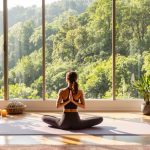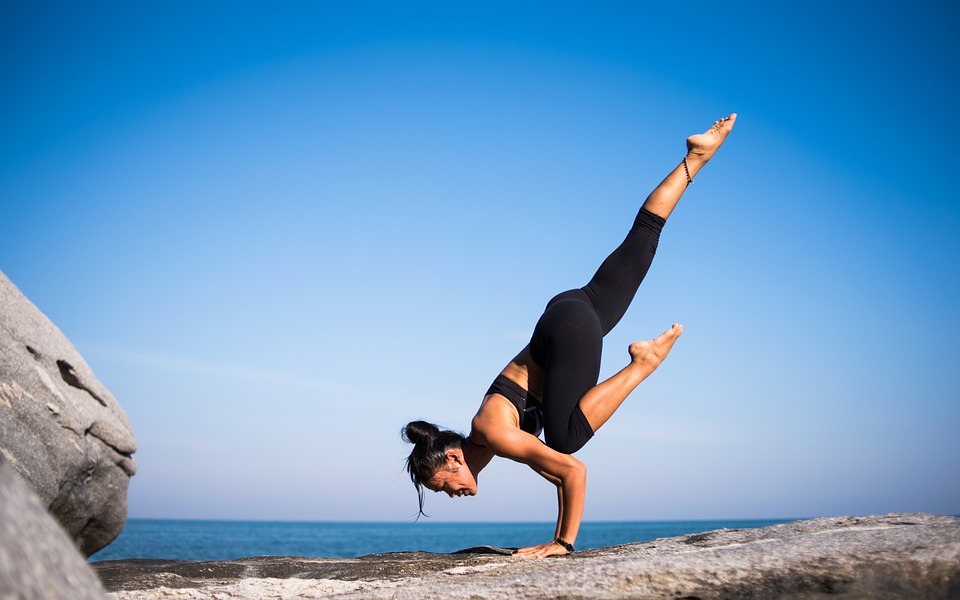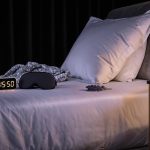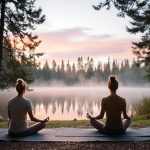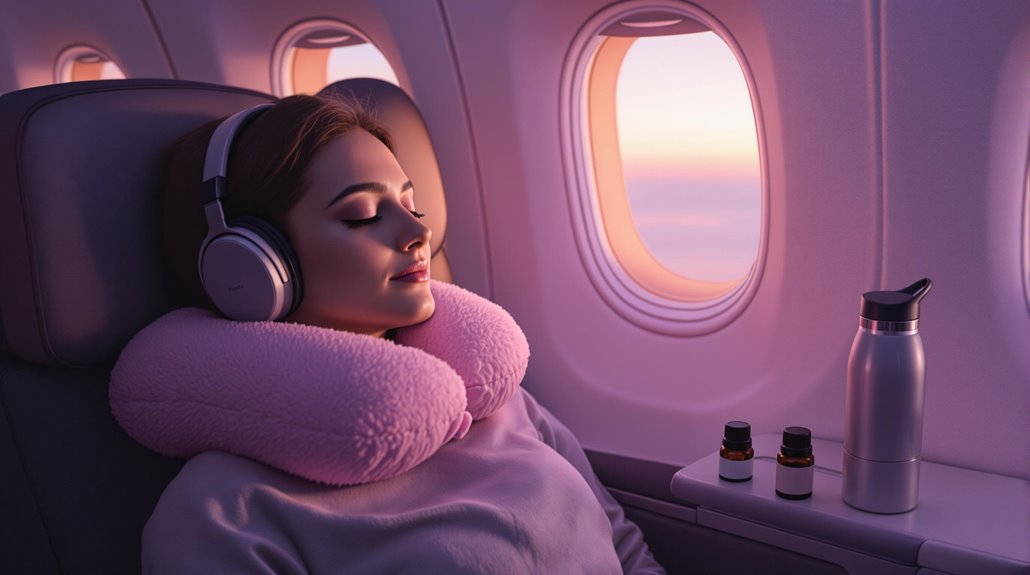
To boost your travel sleep hygiene, start with meticulous pre-travel preparation by creating a detailed checklist to reduce stress. Choose sleep-friendly accommodations by evaluating noise insulation and comfort, and remember your earplugs and sleep mask. Stick to your usual sleep routine and gradually adapt to new time zones to minimize sleep disruption. Combat jet lag by adjusting your schedule before departure and guaranteeing daylight exposure upon arrival. Utilize personal comforts like a travel pillow and practice mindfulness to ease anxiety. These strategies will guarantee a restful journey, and there are additional insights that can further enhance your travel experience.
Pre-Travel Preparation
When you’re getting ready for a trip, preparation often plays a fundamental role in minimizing stress. Creating a solid travel checklist helps you get everything in order and lets you relax, knowing you’re not forgetting essential details. Draft your list well ahead of time, covering everything from packing strategies to travel documents.
Start by listing essentials—clothing, toiletries, and travel accessories. Think about the specific needs of your journey, like climate and activities, to customize this checklist to your liberation-loving soul. Consider how altering eating and sleeping schedules can lead to significant sleep disturbances, and plan your itinerary to allow for ample rest. Ensuring you have adequate hydration needs covered during your travels can also support your overall wellness and energy levels throughout the journey.
Designing effective packing strategies early on can transform the chaos of last-minute scrambles into a calm, methodical process. Start packing a few days in advance, ticking items off your list to guarantee you’re bringing everything you need without overpacking.
Consider rolling your clothes to save space and prevent wrinkles, and utilize packing cubes to organize items efficiently.
Record trip details such as itineraries and hotel addresses. Keep them accessible on your phone for easy reference.
Don’t forget calming techniques like deep breathing or meditation to maintain focus. Tackle the stress of pre-travel preparation head-on, so you set out on your trip with confidence and tranquility.
Choosing Sleep-Friendly Accommodations
Finding the perfect sleep-friendly accommodation can make or break the restorative rest you desperately need while traveling. To guarantee you wake up refreshed and ready to explore, pay attention to key aspects of room selection and noise management.
Here’s how you can elevate your travel sleep experience:
- Evaluate Accommodation Features: Look for places with excellent sound insulation. Reading reviews about noise levels and comfort can guide your choice. Don’t forget about comfortable beds and appropriate room temperature for a peaceful slumber. Hydration levels can affect sleep quality, so ensure there’s easy access to water in your accommodation.
- Assess Environmental Comfort: Choose rooms that promise tranquility. Opt for settings equipped with reliable air conditioning or heating. It’s essential that your room is free from unwanted light and noise disturbances. Blackout curtains or noise machines come in handy for this.
- Plan for Sleep Disturbances: Consider packing tools like headphones, ear plugs, or a sleep mask. These can greatly mitigate unexpected noises from other guests or environment-related disruptions. Make sure to bring earplugs or headphones to combat external noise or invest in a portable white noise machine to ensure uninterrupted sleep.
Essential Travel Accessories
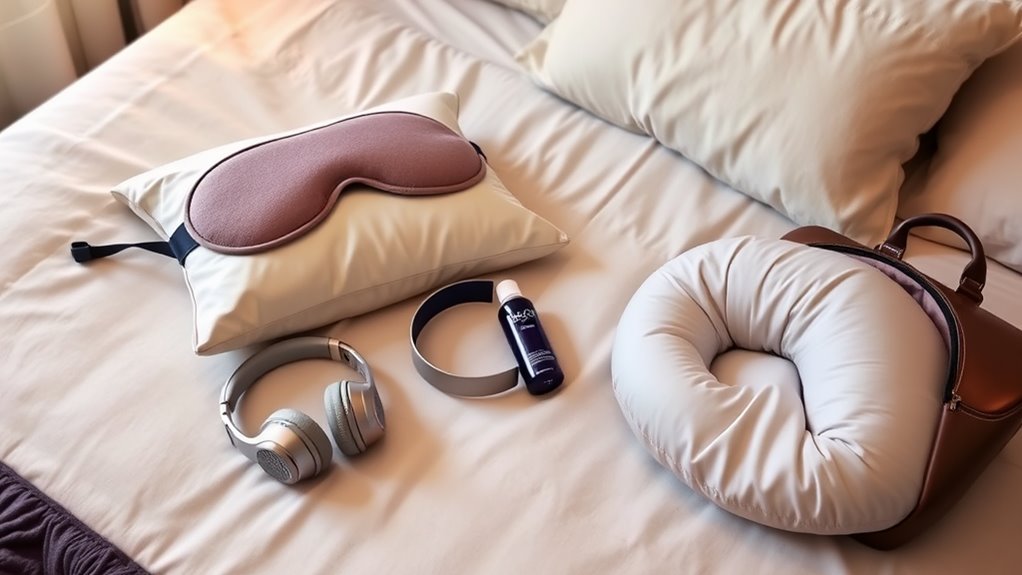
Packing wisely can transform your travel sleep experience by incorporating essential accessories that enhance comfort and ease.
Start with a quality sleep mask to block out intrusive light, a must for both bustling city hostels and brightly lit hotel rooms. Silk masks offer a luxurious yet effective option. Partner this with travel sleepwear that’s both cozy and liberating, ensuring you feel at ease no matter where you lay your head.
To tackle noise pollution on a plane or in a noisy hotel, include earplugs or noise-canceling headphones in your travel arsenal. These tools aren’t just about noise reduction; they create a personal sanctuary for your mind, shielding you from the chaos around you.
Don’t forget a travel pillow to support your head and neck during long journeys. Whether you choose a compact inflatable option or improvise with rolled-up clothing, maintaining a comfortable position makes all the difference.
Walking pace and interval training during travel can also contribute to better sleep by promoting physical fitness, which enhances relaxation. Enhance your sleep environment further with white noise from a machine or app, and consider jotting down thoughts in a sleep journal to ease your mind.
Maintaining Sleep Routine
To maintain your sleep routine while traveling, stick to consistent sleep timings by adjusting your schedule to match the destination’s time zone before you leave.
Engage in familiar pre-bed relaxation activities, like reading or enjoying a warm bath, to signal your body it’s time to sleep.
Keep these habits steady to guarantee your internal clock stays on track even when you’re far from home.
Consistent Sleep Timing
Your body’s sleep routine thrives on consistency, making it essential to stick to fixed bedtime and wake-up times. This is more than just a habit; it’s about maintaining sleep consistency and achieving circadian alignment.
Syncing your sleep schedule with the natural day-night cycle liberates you from the grogginess and fatigue that come with sporadic sleep patterns. To master this balance, consider these strategies:
- Set and Maintain Routine: Establish fixed bedtimes and wake-up times daily, even on weekends, to guarantee your body knows what to expect.
- Adapt Gradually: If you’re shifting to a new schedule, adjust in small increments of 15-30 minutes over several days. Your body’s internal clock will need time to align properly.
- Embrace Natural Light: Let morning sunshine reel you in, as exposure to light in the morning helps synchronize your internal clock, boosting alertness and reducing stress.
Pre-bed Relaxation Activities
Unwinding before bed is essential for ensuring a restful night’s sleep and maintaining your sleep routine while traveling. Breathing exercises like the 4-7-8 Technique can work wonders, swiftly reducing muscle tension and gently lowering your heart rate. You might find progressive muscle relaxation particularly liberating; tense each muscle group, then let go, starting from your toes and working up to your head. This release not only calms but also empowers you to reclaim your nights.
Engaging in these activities can also enhance your sleep experience:
| Activity | Benefits | How to Practice |
|---|---|---|
| Deep Breathing | Reduces tension and stress | Inhale for 4, hold for 7, exhale for 8 |
| Massage/Yoga Nidra | Body and mind relaxation | Devote 10 minutes to mindful body scanning |
| Non-sleep Deep Rest | Calm without sleeping | Focus on relaxation and controlled breathing |
| Self-Hypnosis | Encourages relaxation | Use videos or apps |
For those seeking liberation from life’s constraints, consider indulging in yoga nidra or non-sleep deep rest (NSDR)—practices that let you relax without surrendering to unproductive sleep. Complement these with self-hypnosis for a progressive experience that transforms travel nights into a haven of serenity and self-renewal.
Managing Travel Stress
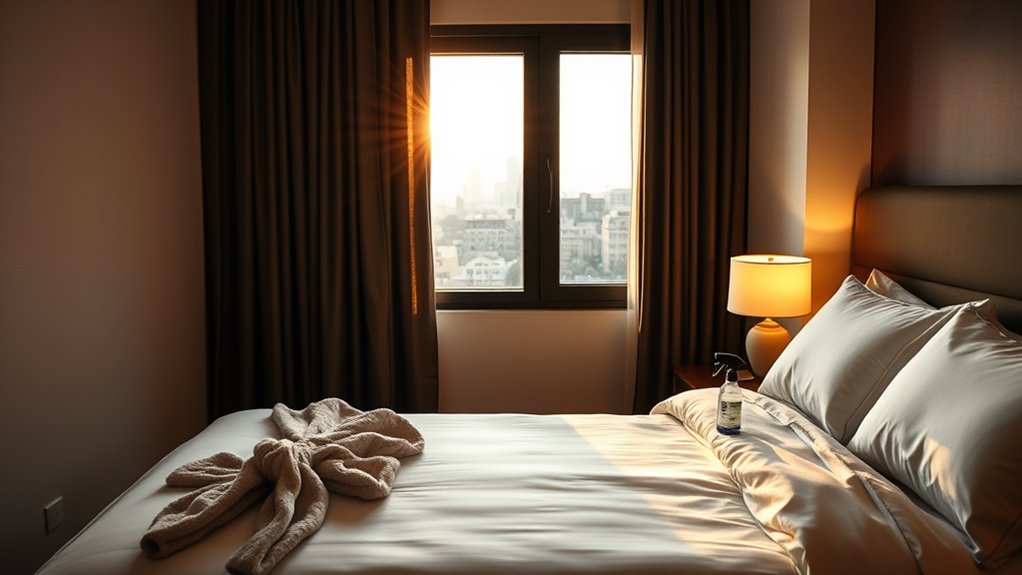
Managing travel stress begins with taking proactive steps to reduce pre-travel anxiety. By planning early and using mindful practices like deep breathing, you’ll guarantee a smooth journey and arrive feeling rested. Incorporating these techniques not only eases stress but also supports your sleep hygiene on the road. Remember that a consistent sleep routine is vital; aiming for 6 to 8 hours of sleep nightly can help manage anxiety and ensure better relaxation and rest during travel.
Pre-Travel Stress Reduction
When it comes to reducing pre-travel stress, thorough planning and preparation can make a significant difference. Start by managing your time wisely and prioritizing what truly matters on your journey. By preparing ahead, you free yourself from unnecessary anxiety, creating space to embrace adventure.
- Plan in advance: Research your destination, including local customs and transportation options. Understanding the essentials gives you confidence and reduces uncertainties.
- Create a flexible itinerary: Allow time for relaxation and exploration. Embracing flexibility means you’re not bound by an overly rigid schedule, which helps ease tension.
- Practice meditation and anxiety management techniques: Use methods like deep breathing or guided imagery to keep anxiety at bay. Meditation practices can transform stressful moments into opportunities for calm introspection.
Your mind’s liberation begins by identifying your anxiety triggers. Maybe it’s boarding a plane or leaving home that triggers stress. Immerse yourself in meditation practices and anxiety management to mitigate these feelings.
Seek to understand the source of your pre-travel stress, allowing you to manage it effectively. With a well-prepared mindset, you’ll effortlessly shift into your travel plans with a sense of peace and anticipation.
Don’t let stress tether you down—unleash your inner wanderlust and set forth with serenity.
Restful Arrival Practices
Upon reaching your destination, guaranteeing a restful arrival can considerably ease travel stress. Adopting restorative practices and integrating arrival rituals will help you reclaim your energy. Begin by prioritizing a balanced, nourishing meal to stave off fatigue. Pair this with a hydration routine to rejuvenate your body. Arrive free from burdens by choosing sleep-friendly accommodations. Seek out places known for comfort and peace—essential elements for sound rest.
| Practice | Description | Benefit |
|---|---|---|
| Sleep-Friendly Stay | Choose accommodations with noise insulation and comfortable beds | Enhanced rest |
| Light, Balanced Meal | Opt for nourishing foods and keep hydrated | Reduced fatigue |
| Immediate Relaxation | Take a short walk or stretch to refresh | Stress relief |
| Stay Active | Incorporate light movement upon arrival | Eases tension and fatigue |
These restorative practices equip you to tackle the day refreshed. Upon check-in, engage in arrival rituals that ground you: unpack with intention, set the room to your preference, and take a brief walk. This not only familiarizes you with the surroundings but also invigorates your spirit. Restorative practices at your destination guarantee you’re not tethered by fatigue, empowering you to embrace the experiences ahead with a liberated mindset.
Mindfulness Techniques Benefits
Traveling often comes with its fair share of stress, but incorporating mindfulness techniques can greatly ease anxiety and improve overall well-being.
Embracing mindfulness meditation offers a straightforward path to calm your mind and enjoy your travel experiences more fully. Here are three transformative benefits of mindfulness in managing travel stress:
1. Reducing Travel Anxiety: Practicing mindfulness meditation helps you stay grounded and present, reducing the overwhelming feelings of travel anxiety.
It frees your mind from the burden of constant worry, letting you savor the moment.
2. Enhancing Sleep Quality: By engaging in mindfulness activities like reading or deep breathing exercises before bed, you signal your body that it’s time to unwind.
This routine leads to improved sleep quality, ensuring you wake up refreshed and ready for your adventures.
3. Managing Jet Lag: A consistent bedtime routine, even while traveling, aligns your internal clock with your destination’s time zone.
Simple strategies like gradual sleep schedule adjustments and exposure to natural light help you beat jet lag effectively.
Adapting to New Environments
Adjusting to new environments can make it challenging to maintain good sleep hygiene, particularly when dealing with the common “First-Night Effect.”
Sleep quality tends to be worse during the first night in a new location because your brain partially remains alert as a survival mechanism. It’s that primal instinct, keeping you aware of environmental disruptions like unfamiliar sounds or a slightly stiff mattress. Even in a luxury spa setting, you’re not immune. After surviving that initial challenge, rest assured, your sleep typically gets better.
Meanwhile, choosing sleep-friendly accommodations becomes an act of self-liberation. Prioritize places with good sound insulation and cozy beds.
Don’t just trust the pretty pictures; reviews are your allies here. Request a room tucked away from the chaos of elevators and ice machines. Saunter into your new space armed with personalized comforts from home—your travel pillow, eye mask, earplugs, and, yes, even a silk pillowcase if it makes you feel like royalty.
Enhance your environment by controlling the temperature and blocking out intrusive light.
Wear loose clothes, block noise with headphones, or mask it with white noise. With these strategies, you’re creating your safe, liberating cocoon, even in an unfamiliar territory. Practicing deep breathing techniques can further enhance relaxation and create a more serene sleep environment.
Tips for Jet Lag Adjustment
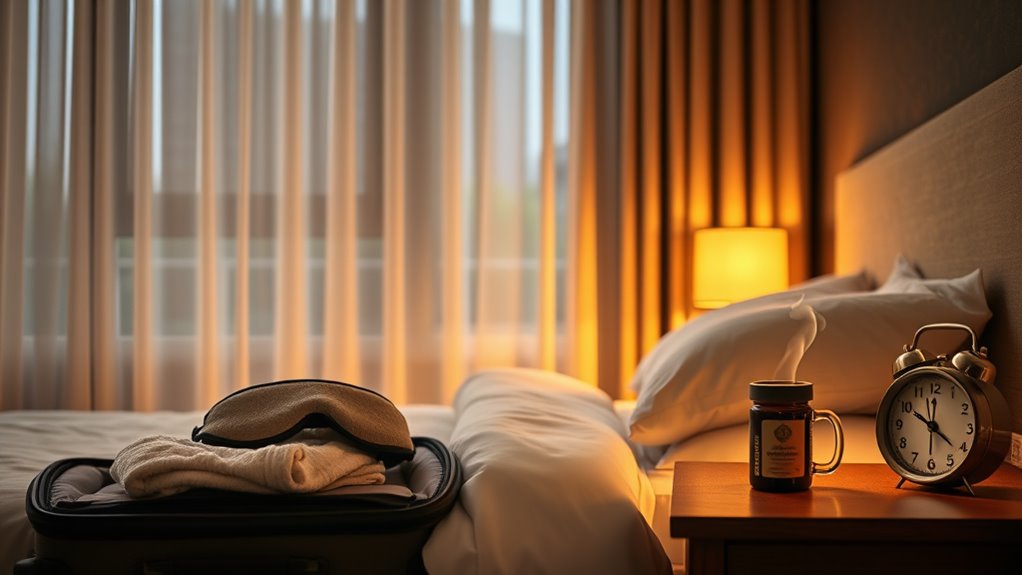
Jet lag can be a formidable hurdle for travelers crossing multiple time zones, but with careful planning, you can minimize its effects. Embracing a routine that aligns with your body’s natural rhythms is essential.
Here are three effective jet lag remedies to set you free from its grasp:
1. Pre-Flight Adjustments: Begin by gradually shifting your sleep schedule 1-2 days before departure to sync with your destination’s time zone. Adjust your meal times accordingly, easing the shift.
Also, steer clear of caffeine and alcohol, and make sure you get plenty of restorative sleep to reduce your sleep deficit.
2. In-Flight Strategies: Synchronize your in-flight sleep with the destination’s time zone. Equip yourself with noise-canceling headphones, an eye mask, and stay hydrated by drinking water.
Remember, light meals make for a smoother journey, and stretching keeps muscle stiffness and clots at bay.
3. Post-Flight Light Exposure: Upon arrival, expose yourself to daylight to help reset your circadian rhythm. Limit blue light at night to aid sleep adjustment.
Morning exercise can be your ally in boosting alertness and adapting faster.
Embrace these steps, liberate yourself from the clutches of jet lag, and enjoy your travels!


